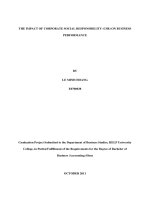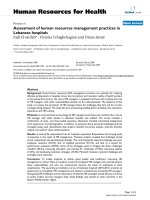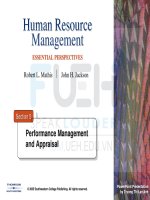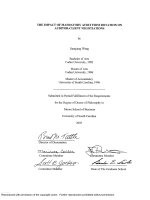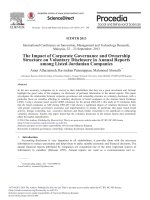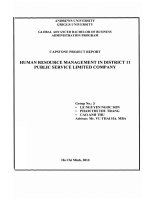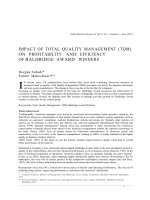Researching about impact of human resources management practices on organization performance
Bạn đang xem bản rút gọn của tài liệu. Xem và tải ngay bản đầy đủ của tài liệu tại đây (939.48 KB, 88 trang )
RESEARCH PROJECT
(BMBR5103)
RESEARCHING ABOUT IMPACT OF
HUMAN RESOURCES MANAGEMENT PRACTICES
ON ORGANIZATION PERFORMANCE
STUDENT’S FULL NAME
:
VU HOANG GIA LINH
STUDENT ID
:
CGS00018489
INTAKE
:
SEPTEMBER, 2014
ADVISOR’S NAME & TITLE
:
ASSOC. PROF. PHAN DINH NGUYEN
December, 2015
ACKNOWLEDGEMENT
It is with greatest respect and veneration; I express my sincere thanks to my
professor Dr. Nguyen Phan who has been a source of personal encouragement, moral
support, and invaluable guidance throughout the preparation of this thesis.
I express my deepest gratitude to managers, assistants, supervisors and
employees who are working in different departments of different hotels in Sea Dragon
Hotel Group for providing me the necessary data and assistance to carry out this
research successfully.
I take this opportunity to wish my heartfelt thanks to Lecturers of International
Training Institute in HCMC University of Technology for providing constant assistance
to reach my academic goals.
This thesis would never have seen the sun without the full support of my
mother. She is my greatest supporters. She provides me with love, guidance and
endless support. These are things I will never be able to repay.
As well as, I wish to thank my friends who encouraged and supported me to
complete this thesis successfully.
Ho Chi Minh City, December 12th, 2015
Vu Hoang Gia Linh
Impact of human resources management practices
on organization performance
Page 2
ADVISOR‟S ASSESMENT
...............................................................................................................................
...............................................................................................................................
...............................................................................................................................
...............................................................................................................................
...............................................................................................................................
...............................................................................................................................
...............................................................................................................................
...............................................................................................................................
...............................................................................................................................
...............................................................................................................................
...............................................................................................................................
...............................................................................................................................
Advisor’s signature
Impact of human resources management practices
on organization performance
Page 3
ABSTRACT
Given the strategic relevance of Human Resources Management (HRM) in
organizations and the lack of scientific instruments to measure employees‟ perceptions
about policies and practices of HRM, this study aimed to validate the Human
Resources Management Practices through exploratory and confirmatory factor analysis.
HRM practices affect service performance that is one of major organizational outcomes
of hotels. The hypothesized model has been considered as a mediator between
employee perceptions of HRM practices and service performance. A six-factor model
was generated showing high-reliability and good fit. There are recruitment and
selection, training and development, career planning system, participation and
involvement, compensation and benefits, performance appraisal.
Hospitality managers do not seem to know how to answer questions about the
future, especially in what concerns the best strategies for human resources retention.
On the bases of these findings, this study also concludes that human resource managers
have a valuable role to play in the executive management teams of hotels. This role
needs to be further developed and encouraged. The current and emerging challenges
facing the hospitality industry demand an approach to HRM which is far more strategic
than the traditional focus of personnel administration; instead, HRM has a key role to
play in creating and sustaining competitive advantage in organizations. This study
contributes in the area of Human Resources Management since Human Resources
Management Practices can be used not only in relational studies but also as an
evaluation instrument by managers who wish to improve their employees‟ well – being
as well as organizational outcomes.
Impact of human resources management practices
on organization performance
Page 4
Table of Contents
ACKNOWLEDGEMENT................................................................................................ 2
ABSTRACT ..................................................................................................................... 4
LIST OF TABLES ........................................................................................................... 8
LIST OF CHARTS ......................................................................................................... 10
CHAPTER 1: INTRODUCTION ............................................................................... 11
1.1
Introduction ................................................................................................... 11
1.2
Problem Statement ........................................................................................ 13
1.3
Research Objective ........................................................................................ 14
1.4
Research Question ......................................................................................... 14
1.5
Significance of the study ............................................................................... 15
1.6
Scope and limitation ...................................................................................... 15
1.7
Definition of terms ........................................................................................ 15
CHAPTER 2: LITERATURE REVIEW ................................................................... 17
2.1
Hospitality industry in Vietnam .................................................................... 17
2.2
Human Resources Management Practices .................................................... 18
2.3
Impact of human resources management practices on firm performance..... 18
2.4
Recruitment and Selection............................................................................. 26
2.5
Training and Development ............................................................................ 27
2.6
Career Planning System ................................................................................ 28
2.7
Participation and Involvement....................................................................... 30
2.8
Performance Appraisal .................................................................................. 32
2.9
Compensation and Benefits ........................................................................... 33
2.10 Hypotheses .................................................................................................... 34
CHAPTER 3: METHODOLOGY ............................................................................. 36
Impact of human resources management practices
on organization performance
Page 5
3.1
Research Approach........................................................................................ 36
3.2
Population ...................................................................................................... 36
3.3
Sample ........................................................................................................... 36
3.4
Data analysis.................................................................................................. 37
3.5
Data gathering procedure .............................................................................. 37
CHAPTER 4: DATA PRESENTATION AND ANALYSIS .................................... 39
4.1
Presentation of general information .............................................................. 39
4.1.1
Gender distribution ................................................................................. 39
4.1.2
Age distribution ...................................................................................... 40
4.1.3
Education qualification ........................................................................... 41
4.1.4
Working experience ................................................................................ 42
4.1.5
Distribution of type of hotel ................................................................... 43
4.1.6
Distribution of working time in this hotel .............................................. 44
4.1.7
Distribution of position ........................................................................... 45
4.2
Reliability ...................................................................................................... 46
4.3
The assessment of respondents in HRM practice.......................................... 47
4.3.1
Recruitment and Selection ...................................................................... 47
4.3.2
Training and Development ..................................................................... 48
4.3.3
Career Planning System.......................................................................... 49
4.3.4
Participation and Involvement ................................................................ 51
4.3.5
Compensation and Benefits .................................................................... 52
4.3.6
Performance Appraisal ........................................................................... 53
4.3.7
Organization performance ...................................................................... 54
4.4
Factor analysis ............................................................................................... 55
4.5
Correlation ..................................................................................................... 58
4.6
Regression Analysis ...................................................................................... 61
4.7
Results ........................................................................................................... 65
Impact of human resources management practices
on organization performance
Page 6
CHAPTER 5: SUMMARY, CONCLUSION, AND RECOMMENDATION ......... 68
5.1
Summary........................................................................................................ 68
5.2
Conclusion ..................................................................................................... 68
5.3
Recommendation ........................................................................................... 69
REFERENCES ............................................................................................................... 71
APPENDIX 1 ................................................................................................................. 80
APPENDIX 2 ................................................................................................................. 83
Impact of human resources management practices
on organization performance
Page 7
LIST OF TABLES
Table 4.1.1: Gender distribution of respondents ........................................................... 38
Table 4.1.2: Age distribution of respondents ................................................................ 39
Table 4.1.3: Education qualification of respondents ..................................................... 40
Table 4.1.4: Working experience of respondents .......................................................... 41
Table 4.1.5: Type of hotel distribution of respondents ................................................. 42
Table 4.1.6: Working time distribution of respondents ................................................ 43
Table 4.1.7: Position distribution of respondents .......................................................... 44
Table 4.2: Reliability Statistics for six HRM practices ................................................. 46
Table 4.3.1: The Assessment of Respondents on HRM in Terms of Recruitment and
Selection ........................................................................................................................ 46
Table 4.3.2: The Assessment of Respondents on HRM in Terms of Training and
Development ................................................................................................................. 47
Table 4.3.3: The Assessment of Respondents on HRM in Terms of
Career Planning System ................................................................................................ 48
Table 4.3.4: The Assessment of Respondents on HRM in Terms of Participation and
Involvement ................................................................................................................... 50
Table 4.3.5: The Assessment of Respondents on HRM in Terms of Compensation and
Benefits .......................................................................................................................... 51
Table 4.3.6: The Assessment of Respondent on HRM in Terms of Performance
Appraisal........................................................................................................................ 52
Table 4.3.7: Organization performance ......................................................................... 53
Impact of human resources management practices
on organization performance
Page 8
Table 4.4a: KMO and Bartlett's Test ............................................................................. 54
Table 4.4b: Rotated Component Matrix ........................................................................ 55
Table 4.5a: Descriptive Statistics .................................................................................. 58
Table 4.5b: Correlations Among Variables .................................................................. 59
Table 4.6.1: Model Summary ........................................................................................ 61
Table 4.6.2: ANOVA .................................................................................................... 61
Table 4.6.3: Coefficients ............................................................................................... 62
Impact of human resources management practices
on organization performance
Page 9
LIST OF CHARTS
Chart 4.1.1: Gender distribution of respondents ........................................................... 39
Chart 4.1.2: Age distribution of respondents ................................................................ 40
Chart 4.1.3: Education qualification of respondents ..................................................... 41
Chart 4.1.4: Working experience of respondents .......................................................... 42
Chart 4.1.5: Type of hotel distribution of respondents ................................................. 43
Chart 4.1.6: Working time distribution of respondents ................................................. 44
Chart 4.1.7: Position distribution of respondents........................................................... 45
Impact of human resources management practices
on organization performance
Page 10
CHAPTER 1: INTRODUCTION
1.1
Introduction
Human Resource Management is the process of developing, applying and
evaluating policies, procedures, methods and programs relating to the employment,
motivation, maintenance, and management of people in the organization. Human
resources management include activities like strategic HRM, human capital
management, corporate social responsibility, human resource planning, recruitment,
selection, training and development, reward management, performance management,
employee relations, health safety and employee well-being as well as provision of
employee services. It comprises a set of practices and policies designed to maximize
organizational integration, employee commitment, flexibility and quality of work
(Armstrong, 2009).
Effective human resource practices relate to company performance by
contributing to employee and customer satisfaction, innovation, productivity, and
development of a favorable reputation of the firm in the industry. A number of
researchers have reported that HR practices are positively linked with organizational
and employee performance.
Researchers have argued that human resources may be seen as a source of
sustained competitive advantage for organizations (Barney, 1991; Becker &Gerhart,
1996). The underlying assumption is that human resources are unique to the extent that
competitors cannot imitate them. Research has led to the identification of a number of
human resource management practices that contribute to company performance across
different organizations (Huselid, 1995). In a literature review, Delery & Doty (1996)
identified seven such practices that have been consistently considered HRM practices.
They defined HRM practices as those that are theoretically or empirically
related to overall organizational performance. These practices include internal career
opportunities, formal training systems, results-oriented appraisals, employment
Impact of human resources management practices
on organization performance
Page 11
security, participation, job descriptions, and profit sharing. This approach has come to
be known as the “best practices” or universalistic approach. Within the best practices
approach to strategic HRM, the first practice, internal career opportunities, refers to the
organizational preference for hiring primarily from within. Second, training systems
refers to whether organizations provide extensive training opportunities for their
employees or whether they depend on selection and socialization processes to obtain
required skills. Third, appraisals are conceptualized in terms of outcome-based
performance ratings and the extent to which subordinate views are taken into account
in these ratings. Fourth, employment security reflects the degree to which employees
feel secure about continued employment in their jobs. Although formalized
employment security is generally on the decline, organizations may have either an
implicit or an explicit policy. Fifth, employee participation, both in terms of taking part
in decision making and having opportunities to communicate suggestions for
improvement, has emerged as a strategic HRM practice. Sixth, job description refers to
the extent jobs are tightly and clearly defined so that employees know what is expected
of them. Finally, profit sharing reflects the concern for overall organizational
performance on a sustainable basis (Delery & Doty, 1996).
Over the years, researchers have suggested many HRM practices that have the
potential to improve and sustain organizational performance. These practices include
emphasis on employee selection based on fit with the company‟s culture, emphasis on
behavior, attitude, and necessary technical skills required by the job, compensation
contingent on performance, and employee empowerment to foster team work, among
others. Purcell et al., (2003) pointed out that the most successful companies had 'the big
idea‟; they had a clear vision and a set of integrated values. They were concerned with
sustaining performance and flexibility which reveals a clear evidence of positive
attitudes towards HR policies and practices, level of satisfaction, motivation and
commitment, as well as overall operational performance.
Impact of human resources management practices
on organization performance
Page 12
1.2
Problem Statement
Hospitality industry is considered a sub category within the services industry
and has experienced significant growth with expanding global economy and positive
changes pertaining to travel and hospitality industry in global environment. Further,
services industry is widely accepted to be driven by customer satisfaction and therefore
human resources are essential component of service delivery. Human resources are the
most important resource hotels have since when we talk of hospitality we talk of a
service, where the person who delivers it, is a vital part. Both the client and supplier
affect service and human resources development is the starting point for success in
hospitality organizations. Thus, the tourism industry and specially the hotel sector,
considering its main characteristics, more than any other sector, faces the need to put in
practice the human resources management practices.
Employees‟ service performance plays an important role in shaping the
customer‟s perception of service quality. Based on a hotel‟s service performance
relative to its competitors to constantly strengthen its market position is critical. Min, et
al. (2002) considered that customer satisfaction is one of the most important strategic
weapons of best practice hotel organizations. Hotel organizations can use some
mechanism to lead and educate their employees as to how the organization value
excellent service and to get policies and procedures implemented (Liao and Chuang,
2004).
Wood (in Baum, Amoah e Spivack, 1997) refer that mainly because of the
personal service nature of the work involved, in most developed countries, both
industry employees and wider society view hotel and catering labor as a relatively low
status. Besides, the hotel sector has some important features that need specific
strategies namely, a high proportion of unskilled labor; a set of competencies that are
easily transferable between hotel units; high turnover rates; low wages (unskilled
nature of the work creates an excess of supply that keep wages down).
Impact of human resources management practices
on organization performance
Page 13
Studies also conducted by Hoque (1999), Alleyne et al. (2006) and Chand and
Katou (2007) have examined HRM practices in hotel industry in UK, Barbados and
India respectively. Although the studies have been conducted in different years and
there is a significant gap between the studies, comparison of HRM practices in these
studies provide significant insights on the adoption of HR practices in three countries.
Based on the findings of the above studies it can be stated that HRM in the hotel
industry is widely adopted and researches are emerging from developed and emerging
markets examining HRM practices. Therefore, this study focuses on identifying HRM
practices in the Hotel industry. The present study aims to approach the importance of
HR in hospitality organizations and giving the working conditions in the hotel sector, to
emphasize the vital role of HRM. Therefore, this research will allow us to study the
reality of hotels in Sea Dragon Hotel Group, in what concerns the current practices of
HRM, as well as changes industry leaders expect to make in the organizations in the
near future.
1.3
Research Objective
This study aimed to analyze the “Impact of human resource management
practices on organization performance in the hotels”. Specifically, the following listed
objectives are identified in addition to the main objective to achieve through this
research:
- To identify the human resources management practices those are used in hotels
in Sea Dragon Hotel Group
- To examine the relationship between human resources management practices
and performance of hotels
- To suggest some measures in order to enhance the human resources
management practices of the hotels
1.4
Research Question
Two specific research questions are posited in the thesis:
Impact of human resources management practices
on organization performance
Page 14
1.5
-
What are the HR practices?
-
How do HR practices affect organization performance?
Significance of the study
The impact of HRM practices on organizational performance has emerged as the
dominant research issue in the HRM field.
This study is significant for HRM practices in hospitality industry. Results will
indicate relationships between HRM practices and hotels performance. Findings of this
research will be helpful to managers to examine the success of HR practices which are
currently implemented by them and to identify HRM outcomes of them. It will assist
owner manager and HR managers to improve performance and profitability of their
businesses by managing human resource matters efficiently and effectively.
1.6
Scope and limitation
The study was conducted to assess impact of human resource management
practices on the organizational performance of the hotels in Sea Dragon Hotel Group.
A total of 100 people, include managers of departments, assistants, supervisors and
employees of the hotels in Sea Dragon Hotel Group were selected to be the respondents
of the study. The study was limited to determine the perception of the respondents on
the human resource practices of the hotels in Sea Dragon Group which are classified in
aspects namely: Recruitment and Selection; Training and development; Career
planning System; Participation and Involvement; Compensation and Benefit; and
Performance appraisal.
The 340 selected respondents were given a questionnaire designed by the
researcher and they complete the questionnaires after being explained and instructed.
1.7
Definition of terms
HRM Policies: Policy is a course of principle of action adopted or proposed by
an organization or individual. HRM Policies are principle of action related to human
resources management. Studies examining the extent to which all employees are valued
Impact of human resources management practices
on organization performance
Page 15
by the organization are exemplified by the research into equal employment opportunity
and affirmative action policies.
HRM Practices: Practice is the actual application or use of a plan or method. As
demonstrated in Baron and Kreps (1999) and Poole and Jenkins (1996) effective
strategic HRM relies on choosing the right practices to achieve alignment with business
strategic. Therefore, we have operational strategic HRM by focusing on the HR
practices used to meet business needs in terms of staffing, appraising, training,
developing, compensating and organizing.
Recruitment and Selection: Looking for employees, encourage them to apply,
and select them, aiming to harmonize people‟s values, interests, expectations and
competences with the characteristics and demands of the position and the organization.
Training, Development & Education: Based on training need assessment, the
official and ongoing educational activities within an organization designed to enhance
the fulfillment and performance of employees.
Involvement: Creating an affective bond with its employees, contributing to
their well-being at work, in terms of acknowledgement, relationship, participation and
communication.
Career Planning System: Based on clear career ladder, aligned goals with
organizational vision, used for succession planning, transparent internal hiring, and
equal unambiguous employment opportunity.
Competency-Based Performance Appraisal: Evaluating employee‟s performance
and competence, supporting decisions about promotions, career planning and
development.
Compensation and Rewards: Based on expectancy of employees, comparable
with market packages, competency based, performance based, profit sharing based
mechanism, covering both financial and non-financial dimensions, reward employees‟
performance and competence via remuneration and incentives.
Impact of human resources management practices
on organization performance
Page 16
CHAPTER 2: LITERATURE REVIEW
2.1
Hospitality industry in Vietnam
Vietnam continues to emerge as a prominent destination for international
travelers within Southeast Asia. With the presence of diverse tourism attractions,
Vietnam appeals to a range of visitors. Foreign direct investment into Vietnam
continues to grow, stimulating developments in infrastructure, enhancing domestic
connectivity. The government continues to be a key driver of the tourism industry
providing incentives for investors and promoting Vietnam as a destination overseas.
Growth in tourism and visitation has spurred investment into the country especially in
the hospitality, real estate and industrial sectors.
According to Global Report (Elly Earls, 2015), Vietnam is growing into a much
larger blip on the radar that‟s drawing hotel investors and developers from around the
world. In the past three years, hotel occupancy across Vietnam has been strengthening,
according to global real estate company CBRE. Occupancy rates in the country‟s main
hubs, Ho Chi Minh City and Hanoi, now are inching closer to major Asian cities like
Jakarta and Kuala Lumpur.
Hotel supply in Ho Chi Minh City and Hanoi is forecast to grow over the next
three years by approximately 8%. The extra rooms will be needed to satisfy increasing
tourist arrivals. Though growth rates have slowed from 19.1% in 2011 to 11% in 2013,
the first five months of 2014 showed an increase in arrivals of more than 26%,
according to CBRE.
It‟s not just tourists that are increasingly opting to visit Vietnam. “Business
demand for hotels is driven by Vietnam‟s position as a low-cost manufacturing base, as
industrial business seeks alternatives to China,” said Adam Bury, VP of investment
sales for Jones Lang LaSalle Asia Pacific.
Add to this the fact that Vietnam is, according to CBRE Hotels executive
managing director Art Buser, one of the world‟s “high frontier growth markets”, with
Impact of human resources management practices
on organization performance
Page 17
an average gross-domestic-product increase of 6.8% from 2003 through 2013, as well
as a more affordable option than nearby countries like Hong Kong, Singapore and
Tokyo, and it‟s little wonder that there has been growing investor interest in the
country.
2.2
Human Resources Management Practices
Human resource management (HRM) refers to the policies and practices
involved in carrying out the human resource(HR) aspects of a management position
including human resource planning, job analysis, recruitment, selection, orientation,
compensation, performance appraisal, training and development, and labor relations
(Dessler, 2007). The Human Resource Management (HRM) activities can be
summarized briefly under five major domains: (i) organizational design; (ii) staffing;
(iii) performance management appraisal; (iv) employment training and organization
development; and (v) reward systems, benefits and compliance (Beardwell, et al.,
2004). The overall purpose of human resource management is to ensure that the
organization is able to achieve success through people (Armstrong, 2006). However, as
obtained in the literature, HRM is said to be concerned with achieving the following:
organizational effectiveness; human capital management; knowledge management;
reward management; employee relations and meeting various needs (Armstrong, 2006).
HRM is composed of the policies, practices, and systems that influence employees‟
behavior, attitude, and performance (Noe, Hollenbeck, Gerhart, and Wright, 2007).
2.3
Impact of human resources management practices on firm performance
Recent academic research has attempted to demonstrate the impact of HRM on
firm performance and the relationship between the practices and firm outcomes is
discussed best in the strategic human resource management literature (Pfeffer, 1998;
Rogers & White, 1998). Early studies linked individual HR practices such as training,
selection, performance appraisal and compensation to firm financial performance
Impact of human resources management practices
on organization performance
Page 18
(Huselid, 1995; Guest, 1997). Traditional HRM factors alone are no longer sufficient in
maintaining firm strategy. Even though HR departments have historically been
bureaucratic within organizations, its role has been focused on pursuing more flexible
and creative means to deliver services in constantly changing environments (Lepak&
Snell, 1999). HR professionals are increasingly expected to become much more
responsive, efficient, and ultimately make a strategic contribution to their company.
Designing and integrating human resources systems is one of the ways to ensure the
creation of value for customers and sustain organizational effectiveness. The notion of
best practices in human resource management has received a lot of attention in recent
years. It has been suggested that there is a universal set of human resource best
practices that can maintain a firm's performance (Lau & Ngo, 2004).
There is growing evidence that corporate HRM practices are associated with
high financial performance, and can encourage employee behavior and attitudes
towards strengthening the competitive strategy of an organization (Hiltrop, 1996).
Successful firms create a bundle of employee practices to reinforce the
organizations‟ strategic position (Enz & Signaw, 2000). Hiltrop (1999), in his research
asked the HR managers and personnel officers in 319 companies in Western Europe
about HR policies and practices of their firm and found out that employment security,
opportunities for training and development, recruitment and selection from within,
career development and teamwork, participation and proactive personnel planning are
the most important practices. In fact the role of HR is to acquire, develop, manage,
motivate and gain the commitment of the employees. The focal point is how to
determine the best practice in various HR-related decisions (Baruch, 1998). In a
comprehensive study on best practices in the lodging industry, Enz&Signaw (2000)
examined five categories of HR best practices; (i) Leader development, (ii) Training
and knowledge building, (iii) Employee empowerment, (iv) Employee recognition and
Impact of human resources management practices
on organization performance
Page 19
(v) Cost management. Similarly, Jayaram et al.,(1999) stated that the broad range of
human resource management practices affecting performance can be classified into five
major topics: (i) Top management commitment; (ii) Communication of goals; (iii)
Employee training; (iv) Cross functional teams; and (v) General HRM practices. This
classification implies that human resources management practices can be analyzed
using the five broad groupings of practices (Jayaram et al., 1999). On the other hand,
Pfeffer (1998) has proposed seven HRM practices that are expected to enhance
organizational performance. The practices he proposed are: (i) Employment security.
(ii) Selective hiring of new personnel. (iii) Self-managed teams and decentralization of
decision making as the basic principles of organizational design. (iv) Comparatively
high compensation contingent on organizational performance. (v) Extensive training to
provide skilled and motivated workforce. (vi) Reduced status differentials and barriers,
including dress, language, office arrangements, and wage differences across levels.
(vii) Extensive sharing of financial and performance information throughout the
organization (Pfeffer, 1998).
In knowledge - based competitive economy, the adoption of appropriate HRM
practices is important to ensure effective strategy implementation. HRM practices
create procedures that constitute the building of employees‟ knowledge and skills
throughout the organization to promote valued and unique organizational competencies
which support competitive advantage (Werbel & DeMarie, 2005). Strategic human
resource management has become a more central issue to management literature from
empirical research view linking HRM practices with firm performance and profitability
(Delaney & Huselid, 1996; Becker & Gerhart, 1996). To a very large extent, the
philosophy and approaches to HRM practices are underpinned by the resource-based
view, which states that it is the range of resources in an organization, including its
human resources, that produces its unique character and creates competitive advantage.
According to Barney (1995), competitive advantage arises first when firms within an
Impact of human resources management practices
on organization performance
Page 20
industry are heterogeneous with respect to the strategic resources they control, and
second, when these resources are not perfectly mobile across firms and thus
heterogeneity can be long lasting. Creating sustained competitive advantage therefore
depends on the unique resources and capabilities that a firm brings to competition in its
environment. These resources include all the experience, knowledge, judgment, risktaking and wisdom of individuals associated with the firm.
For a firm resource to have the potential for creating sustained competitive
advantage it should have four attributes: it must be valuable, rare, imperfectly imitable
and non-substitutable. To discover these resources and capabilities, managers must
look inside their firm for valuable, rare and costly-to-imitate resources, and then exploit
these resources through their organization. Wright et al., (2001) noted that there are
three important components of HRM that constitute a resource for the firm and are
influenced by HR practices: (i) the human capital pool - the stock of employee
knowledge, skills, motivation and behaviors. (ii) The flow of human capital through the
firm - the movement of people and of knowledge. (iii) The dynamic processes through
which organizations change and renew themselves. They suggested that HR practices
are the primary levers through which the firm can change the pool of human capital as
well as attempt to change the employee behaviors that lead to organizational success.
Resource – based HRM can produce what Boxall & Purcell (2003) referred to as
human resource advantage. The aim is to develop strategic capability. This means
strategic fit between resources and opportunities, obtaining added value from the
effective deployment of resources, and developing people who can think and plan
strategically in the sense that they understand the key strategic issues and ensure that
what they do supports the achievement of the business‟s strategic goals. In line with
human capital theory, the resource-based view emphasizes that investment in people
increases their value to the firm.
Impact of human resources management practices
on organization performance
Page 21
As Ulrich (1998) commented: “Knowledge has become a direct competitive
advantage for companies selling ideas and relationships. The challenge to organizations
is to ensure that they have the capability to find, assimilate, compensate and retain the
talented individuals they need”. The significance of the resource – based view of the
firm is that it highlights the importance of human capital management approach to
HRM and provides the justification for investing in people through resourcing, talent
management, and learning and development programs as a means of enhancing
organizational capability.
To respond to their customers‟ needs and move forward in their business,
companies should manage their employees‟ special skills as they are viewed as an
important source of competitive advantage. Succeeding to attract, retain and motivate a
skilled workforce helps companies to improve their results. Companies are admitted to
effectively manage their different HR activities such as recruiting, selecting, hiring,
safety, wellness, training, organization development, communication and rewarding
personnel to ensure they help positively in their financial growth and meet their
challenges in a fast-changing business environment. A highly committed and
competent workforce helps companies succeeding these strategies and gain competitive
advantage as long as these strategies are communicated and the workforce is involved
in both the formulation and implementation phases.
Companies should consider people as assets and they are valuable and constitute
a source of competitive advantage. As stated by Armstrong and Baron (2002) that
“people and their collective skills, abilities and experience, coupled with their ability to
deploy these in the interests of the employing organization, are now recognized as
making a significant contribution to organizational success and as constituting a
significant source of competitive advantage.”
Impact of human resources management practices
on organization performance
Page 22
According to Bratton and Gold (2007), strategic human resource management is
“the process of linking the human resource function with the strategic objectives of the
organization in order to improve performance”. They added that SHRM is a managerial
process requiring human resource policies and practices to be linked with the strategic
objectives of the organization.
There is a considerable debate in the literature related to whether the SHRM and
related HR strategies is an outcome or a process. For some academics such as Snell et
al. (1996) the SHRM is an “outcome” where they view the SHRM as an organizational
systems designed to achieve sustainable competitive advantage through people. While
for others, it is a process of linking HR practices to business strategy (Ulrich, 1997).
Similarly, Bamberger and Meshoulam (2000) describe SHRM as the process by which
organizations seek to link the human, social, and intellectual capital of their members
to the strategic needs of the firm‟. Many researchers (Arthur, 1994; Huselid, 1995;
Delaney and Huselid, 1996; Huselid et al., 1997; McMahan et al., 1999; Fey et al.,
2000; Huang, 2001; Stavrou and Brewster, 2005; Christiansen and Higgs, 2008) have
suggested that company‟s HRM practices contribute to increase its performance and
thus help it to grow and gain sustainable competitive advantage. These studies
attempted to answer the question of whether or not human resource management
practices have a crucial role in the creating a high financial performance and sustaining
a competitive advantage in a fast changing environment. Traditionally, human
resources have been viewed as a cost to be minimized (Becker and Gerhart,1996) and
subject to be downsized in order to reduce these costs, rather than a source of value
creation and a strategic lever that can have economically significant effects on the
firm‟s performance (Becker and Gerhart, 1996). As mentioned by Becker and Huselid
(1998), a skilled and motivated workforce can have a very important role to provide the
necessary speed and flexibility to the organization to gain competitive advantage in a
dynamic market environment where traditional sources of competitive advantage
Impact of human resources management practices
on organization performance
Page 23
(quality, technology, economies of scale, etc.) have become easier to be imitated by the
organization‟s rivals.
Huselid (1995) studied the impact of HRM policies and practices on firm
performance. He found that these practices have a significant impact on employee
outcomes (turnover and productivity) and on the overall corporate performance.
Huselid et al. (1997) evaluated the impact of HR managers‟ capabilities on HR
effectiveness and the impact of the latter on the corporate financial performance using a
sample of 293 U.S. firms. They found that effectiveness was associated with
capabilities and attributes of HR staff and that there exists a relationship between HR
management effectiveness and productivity, cash flow, and market value.
Wright et al. (1999) examined the impact of HR practices (selection, training,
compensation and appraisal) and participation of the financial performance of190 US
petro-chemical refineries. Their results confirmed the existence of a direct relationship
between training and compensation with workforce motivation. However, they found
that only under highly participative systems, HR practices (selection, compensation and
appraisal) are positively related to firm performance.
Wan et al. (2002) tested six strategic HR variables‟ (training, staffing,
empowerment, performance appraisal, job design, and performance-based pay) impact
on firm performance and then examined how the combination or the bundle of such
variables together affect this performance. Using a sample of 191 Singaporean
companies, they found that effective implementation of the different strategic HR
variables have a positive effect on organizational outcomes (especially to the firm HR
performance – employee productivity, job satisfaction and commitment). They also
found that performance appraisal and empowerment and training were very important
issue to tackle by top management if they are interested to enhance their HR
performance and hence the organization performance.
Impact of human resources management practices
on organization performance
Page 24
Bae and Lawler (2000) examined the effects of organizational strategic variables
regarding HRM and the source of competitive advantage of 138 Korean firms. They
found that firms with high – involvement HR strategies had better performance.
Batt (2002) examined the relationship between human resource practices,
employee quit rates, and organizational performance in the service sector. His findings
confirm that, firms emphasizing high skills, employee participation in decision making
and in teams, and human resource incentives such as high relative pay and employment
security, have lower quit rates and higher performance (sales growth).
Using a sample of 52 Japanese multinational corporation subsidiaries in the U.S.
and Russia, Park et al. (2003) examined the impact of HR practices on firm
performance. Their result confirmed the hypotheses that employee skills, attitudes and
behaviors play a mediating role between HR systems and firm outcomes.
Paul and Anantharaman (2003) tested the causal model linking HRM with
organizational performance. They found that practices like training, job design,
compensation and incentives had a direct effect on the operational performance
parameters. Sing‟s study (2003) tested and showed that there exists a significant
relationship between strategic HR orientation of Indian firms and their performance.
HR orientation was conceptualized as the alignment of HR planning, selection,
evaluating, compensating, developing and staffing practices with the business strategies
of the firm. In his study of 194 Singaporean companies from different industries, Khatri
(2000) found that there‟s a strong direct influence of HR practices on firm profitability.
Although their findings suggest that the role of HR function in Singapore companies
still remains secondary, they stated that encouraging signs suggest that HR activities
are increasingly being aligned and integrated with the organization‟s overall strategy.
Wattanasupachoke (2009) had explored the relationship between HR strategies
and the performance of 124 Thai companies and found that the extra pay and profit
Impact of human resources management practices
on organization performance
Page 25
